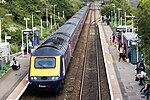Odd Down

Odd Down is an area of the city of Bath, Somerset, England. A suburb of the city, Odd Down is located west and south of the city centre. The city ward population taken at the 2011 census was 5,681.A 1,330 yards (1,220 m) section of the Wansdyke medieval earthwork in Odd Down, which has been designated as an Ancient monument, appears on the Heritage at Risk Register as being in unsatisfactory condition and vulnerable due to gardening.The Cross Keys Inn is a Grade II listed building which was built in the late 17th or early 18th century. although an earlier pub on the site served as a coaching inn.Odd Down A.F.C. is the local football club which won the 2015-16 Western Premier League.
Excerpt from the Wikipedia article Odd Down (License: CC BY-SA 3.0, Authors, Images).Odd Down
Bloomfield Rise, Bath Odd Down
Geographical coordinates (GPS) Address Phone number Website Nearby Places Show on map
Geographical coordinates (GPS)
| Latitude | Longitude |
|---|---|
| N 51.3614 ° | E -2.3813 ° |
Address
St Philip's CofE Primary School
Bloomfield Rise
BA2 2BN Bath, Odd Down
England, United Kingdom
Open on Google Maps










